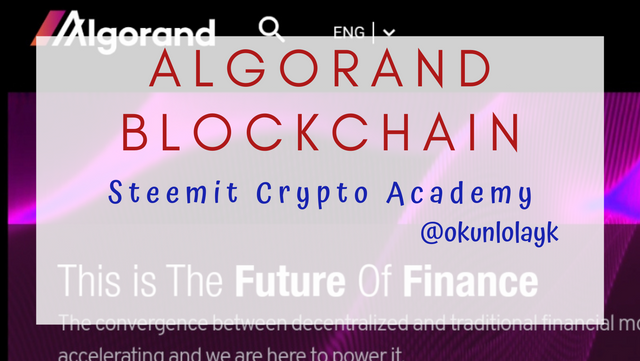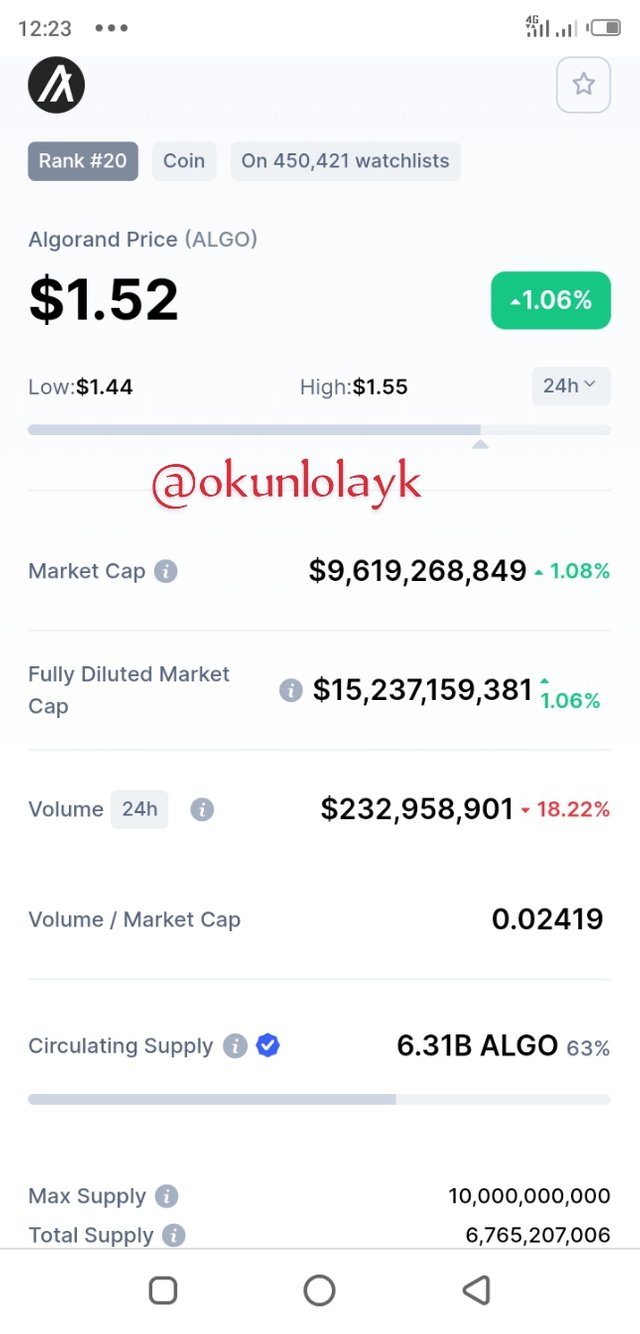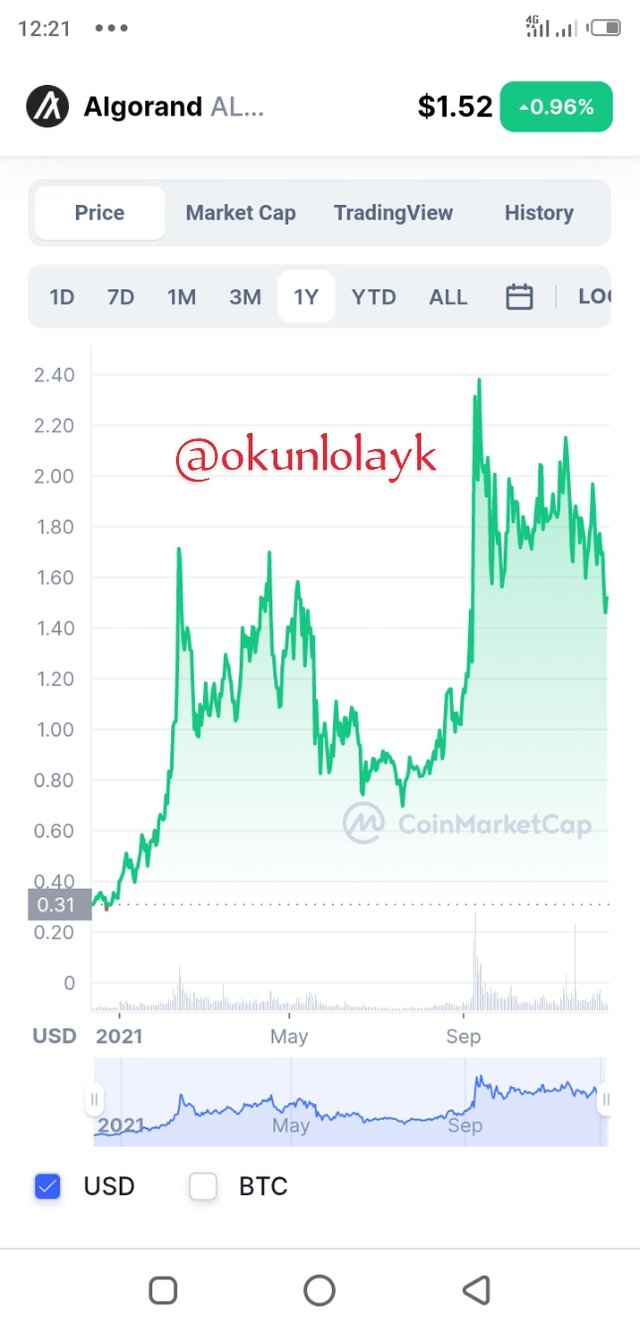

What is Algorand blockchain?

The algorand blockchain was created by Silico Micali in 2017. It was created uniquely out of the distress of the Blockchain Trilemma which is being experienced by existing blockchain protocols. The Blockchain Trilemma is a phenomena of difficulty experienced by Blockchain developers being that they could not effectively satisfy the three main characteristics that is expected of the blockchain network.
However, the Algorand Blockchain technology came into the picture to solve the problem of the Blockchain Trilemma for the first time. The Algorand Blockchain thus provides Decentralization, security and Scalability. The technology uses the Pure Proof of Stake protocol that is built upon Byzantine consensus to govern its activities. The network provides advantageous features over the traditional Proof of work and Proof of stake mechanism. Thereby making the blockchain technology adaptable to contemporary socioeconomic demand of the finance world.
The goal of Micali was to solve the Blockchain Trilemma and build a blockchain system that can be scaled up to meet the demands of today’s world. source

What is PPoS?

The PPoS is the consensus protocol of the Algorand Blockchain. This protocol technically combines some features of the Proof of Work and Proof of Stake consensus. The proof of stake features allows users of the Algorand network to participate in governance according to the amount of token (Algo) held. Although everyone on the network can participate in block creation but the higher the token stake the higher the chances of being picked during the random selection. The PPoS also uses cryptographic decomputation just like the Proof of Work. The participants in race for block creation would have to undergo a computational decryption process which would identify the node that would create the next block.
The Pure Proof of Stake Consensus is executed in the following Phase:
- The Proposal Phase: During this phase, every online user is eligible to participate to propose a block. At this, the protocol randomly picks a token and the owner is chosen to propose a token. This node compiles the block and propagate it to the network alongside a Verifiable Random Function output for validation.
- The Voting and Certification phase: to continue the block creation process a thousand of unique tokens are selected to vote the validity of the block. The individual voting power is based on their proportional share in the pool. The voters confirms the validity of the proposed block. To take things further, a subset committee of these voters are selected at random to testify if the votes were casted honestly or otherwise.
The process of participation, block proposition, voting, validation and block creation forms the principles of Pure Proof of Stake consensus.

Explain the advantages and disadvantages of PPoS.

The Advantages of the PPoS is not far fetched.
- Equal Participation: The consensus mechanism provides an equalized Decentralized system. There is no need for investment in large computational devices as in PoW or acquisition of large stakes as in PoS. Algorand gives an equal opportunity to both rich and poor to participate in the governance of the network.
- High Scalability: Algorand have it blocks created in every 4.5 seconds and holding over 5000 transactions per block. This capacity supports its Scalability throughput of over 2000 transactions per seconds.
- High Security: It is difficult for malicious node to manipulate block creators as they are blinded from knowing the next creator and makes it too late for them to act when they know.
The drawbacks of the PPoS is less significant compared to the advantages it presents. Although the Algorand network supports the presence of Malicious nodes and put them on a chance of 2/3 ratio to take over the network. That is, malicious nodes can only overtake the network if they can occupy up to two-third of the whole network.

Do you think Algorand really solved the blockchain trilemma? Explain your answer.

Algorand was able to solve the blockchain Trilemma by proving the coexistence of these three blockchain features; Decentralization, Security and Scalability. Quite a number of blockhain technologies satisfy the the concept of Decentralization and Security but believed having a strong Scalability throughput would detriment the effectiveness of decentralization and Security.
A blockchain having decentralization simply means the governance of the network is not being controlled by a central body. The network activities are being controlled by consensus among the the participants of the network. The Algorand Blockchain provides an effective decentralization as it allows every participant of the network to participate in block creation and governance of the network. The technology uses cryptographic sorting to randomly pick block creators and validators.
The arm of security is also satisfied as well as it is difficult for malicious personnel to interrupt the credibility of the network due to its diverse governance participants and cascaded levels of validation.
The most unique property of the Algorand network is its Scalability. Scalability is the ability of a network to cope with an increasing number of the Users on the platform. This in other words means the ability of the network to execute a missive number of Transaction per time without causing a rise in Transaction fee. Algorand is scalable as it is capable of executing over two thousand transactions per seconds.
As mentioned earlier, the Algorand is a solution to the Blockchain Trilemma.

Do you think PPoS is better than PoW? Explain your answer.

The Pure Proof of Stake good steps further than the Proof of work. The proof of work is the oldest form of blockchain consensus mechanism and has been found to abhor faults that are restricting it from meeting the social economic demand of it's user. A prevalent fault of the PoW is its level of Scalability. For example the Blockchain uses cryptographic puzzle that sustain the block creation time at 10 minutes.
The cryptographic puzzle decryption is also energy consuming as all particpating nodes would have to burn resources to compete to create a block.
This shows that the PoW is ineffective when it comes to time and resources management. The Algorand comes into play with a Block time of 4.5 seconds with each block holding over 5,000 transactions. This far supersedes PoW Scalability.
Furthermore, considering the value of resources burnt per block creation the PPoS is suitable economically. The consensus use a random selection method and not all participants burn resources to compete.
The PoW is also subjected to 51% attack especially for tokens that has volume which is a threat to the decentralization of the network. The PPoS maintain a total decentralization by a process whereby no other node knows the chosen block creator until the block proposition is done and at such it is difficult to manipulate block proceedings.

Do you think PPoS is better than PoS? Explain your answer.

The PoS is an advancement of the PoW system in which it tries to solve the high energy consumption fault by making use of Stake instead. In PoS an amount of token is locked up as collateral in order to qualify for a participation in the governance of the network. However, the measure of ones power or influence on the network is dependent on the the weight of one's stake. This system gives power to the big investors and shut out less stakes out of governance. The Decentralization of the system can also be breached if the an investor can own up to 51% of the total stake.
However, PPoS solve this through the random selection process by making every online users qualify to participate in block creation.

Explore and explain an ALGO transaction using algoexplorer.io ( Screenshots required)

The activities carried out on the Algorand Blockchain can be explored on algoexplorer.io. The interface displays quite a number of explorable tools as well as details of activities on the Blockchain. These details include the currently ALGO price, total supply, online staked, latest blocks and latest transactions. To check the details of a Transaction- the TxID can be searched in the search box or if recently executed can be seen under latest Transactions.
Below is an overview of a Transaction on algoexplorer.io showing the Transaction ID, Block ID in which it is contained, Timestamp, type of transaction type (transfer), senders ID, amount sent and the receivers ID. Other details include Round ID, sender's balance as well as the receiver's balance.

Carry out an analysis of the price of ALGO from the beginning of the year to the present. Via graphics (screenshots required.)

Below is a current market behavior of the ALGO coin from Coinmarketcap as well as a chart showing the performance of the coin from the beginning of the year. At the beginning of this year an ALGO token was worth 0.31 USD and went through series of Uptrend and dips. It had a massive dip of 0.74 USD during July and an all time of 2.31 USD. ALGO is currently worth 1.44USD at the time of Writing.

conclusion

The main purpose of the Algorand Protocol is to solve the problem of the Blockchain Trilemma. However it has successfully proven its providence of a decentralize, secure and fast network through it's unique features. These features tends to being the Blockchain or Decentralized Finance (DeFi) to a good standing to compete with the centralised form of financial. It's fast and secure feature would thus strengthen the conviction of the world to trust decentralized finance.

Best Regards!!



